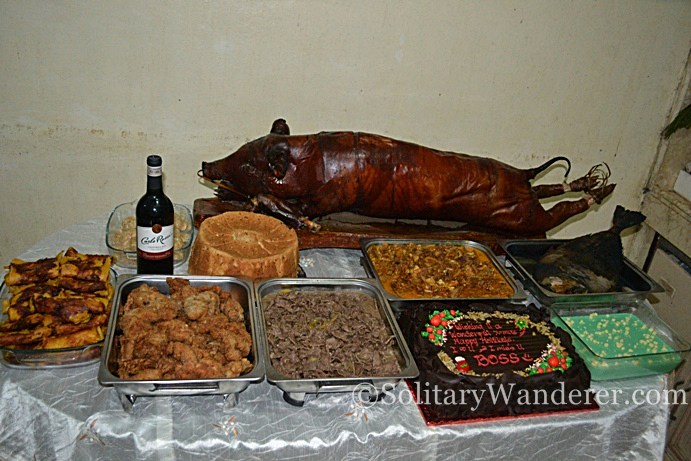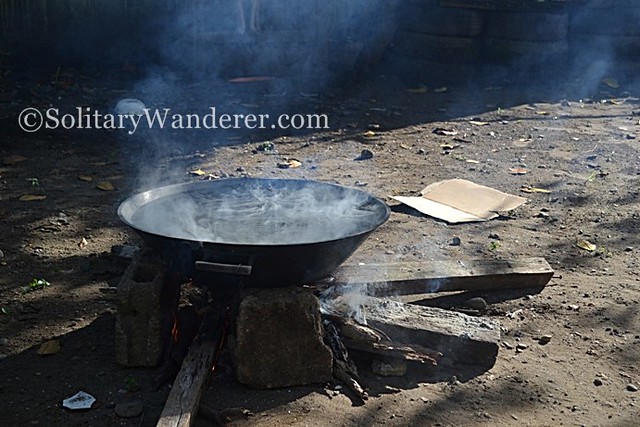This website uses cookies so that we can provide you with the best user experience possible. Cookie information is stored in your browser and performs functions such as recognising you when you return to our website and helping our team to understand which sections of the website you find most interesting and useful.
If there’s one dish that’s a constant in any Filipino celebration, it’s lechon (roasted pig).
In any gathering in the Philippines, you can usually see the whole pig gracing the dining table, making it the highlight of the feast. After the prayers are said, guests immediately flock to it, vying to be the first to get the crispest skin and the choicest meat.
I haven’t eaten meat for some time (except when I don’t have a choice), and even if I start eating again, I won’t eat lechon. I still remember how it tastes, and although I admit it’s delicious, I will never eat it again. I have seen how it’s cooked, and it’s hard to get out of my mind.
People in the cities just go to Lydia’s and other places that sell whole lechon whenever there’s an occasion. For those in the provinces, however, families raise pigs in preparation for special events like birthdays, Christmas eve, and New Year’s Day.
In Tandag, Surigao del Sur, for example, people will buy a piglet, say, in the second quarter of the year in anticipation of it getting bigger in time to be made into a lechon in December. So think of Babe, the pig in the city. Can you really take care of something, give it a name, and then eat it afterwards?
In any case, a few hours before the event, the chosen pig is killed. Usually a quick stab to the throat is enough. There are times though when the pig is stronger, and it can take some time (and a lot more blood) before it dies. When it’s dead, someone will then make sure it gets cleaned. Every inch of it is brushed until all dirt is gone.
While the killing is going on, a huge vat of water is set to boil. This will be used to bathe the pig to make its bristles easier to remove.
When the pig is dead, boiling water is poured all over its body to soften the bristles, and it is then shaved using a knife first, and later on, a blade for closer shaving. This can take some time—which explains why lechon is expensive!—especially when the pig is bigger or older.
After all the external cleaning has been done, the pig’s entrails are taken out. They’re not supposed to be fed hours before it’s scheduled to be butchered. Otherwise, the cook will have a hard time taking out the entrails. Ever wonder what they do with it? The entrails are cleaned up and then cooked! It does make for a good dish, if it’s cleaned properly.
When the pig’s insides are cleaned out, loads of spices and other ingredients are shoved into the cavity. They use a lot of onions, garlic, lemongrass, black pepper, salt, and the whole body is rubbed with seasoning.

A lechonero builds the fire.
The end result is a succulent-looking dish served on its own wooden tray in the middle of the dining table. Sometimes an apple is put into its mouth. The lechon’s choicest parts is its skin, the ribs and the flesh inside the cavity. Some also love taking the whole leg and biting into it.
There you have it. This is how the lechon is made. Filipinos really love this dish. Do you? Would you? 😉
- Why Thailand Is a Great Destination for Solo Travelers - March 21, 2024
- 20 Absolutely Useful Tips For Backpacking Southeast Asia - July 30, 2023
- The Tale of Tonyo the Brave - June 14, 2022




22 Comments. Leave new
its very difficult but not impossible i like filipinos food and there locally food i really enjoyed when i was going to manila last year but i saw it its very hard work to clean this dirty bloods etc..but experince was amazing..
Ang dameng gagawin,, ung mejo nakakadiri dn lalo na ung pagkuha ng mga lamang loob. pero sa huli dabest pdn tlga pag luto na..
Man oh man, I’m drooling right now. Although I just want the end product of the lechon process. Indi ko kaya yung preparation process. Masarap talaga ang lechon sa Pilipinas. Nothing could beat this popular Christmas dish. Sana Pasko na ulit.
Wow I’ve only seen them cook the pig after all the dirty work has been done. I got a little queasy with some of the photos. Pero seeing the finished product bigla akong nagutom. I miss lechon!!!
miss ko na kumain ng lechon!
Haha! I’m too vegetarian for this. But Lechon is a Filipino favorite
ang hirap naman pala gawin ng lechon 🙁
true, the lechon is always there during all types of festivities. always present. but i’m not much of a lechon lover. after a small slice or two, ok na ako dun. minsan nga, i don’t eat at all. not that i don’t like it, it’s just not a favorite
I seldom eat pork, but if it’s lechon? Hell yeah! LOL! I do try to avoid the skin though and would rather dig into the meat. Sigh… I’m suddenly craving 🙁
In my hometown in Bulacan, we prepare and cook litsong baboy the same way. We only differ in what we put on the pig’s stomach. Instead of what you mentioned, we only put rice in it. When done, it’s the tastiest rice one could have. I want to mention also that for medium-sized pig (50 to 100-kg live weight), roasting takes up to four (4) hours.
I remember how roasted pig originated in one of an ancient Chinese tales. The aromatic scent of the roasted piglets attracted a Chinese villager who happened to pass by a burnt house in a certain mountainous place. Due to his curiosity, he spotted several burnt piglets huddled in one place of the said house. He pinched one of it and his finger passed through it. His finger became oily with a piece of meat clinging. He licked his finger to clean it and it tasted great. It was deliciously. He had never tasted a kind of roasted meat for that of a piglet before. The news spread like a wild fire, and lechon or roasted pig became a reality. Others have another version why lechon came to be a the favorite delicacy in every gathering or special occasion.
See what’s real in my photoblog: &nspb;T.R.U.T.H.
Spell CALORIE! hhhaha! Mahirap pala ang paggawa ng lechon. Taga-kain na lang ako. I so love the crispy balat. Whew! High blood attack after a single serving 🙁
I’d like it if it were a lamb or a goat. I don’t eat pork.
WOW! I am a true blue Filipino and I don’t even know that it takes THAT much effort to make lechon. I usually just see it on the table, go for my favorite crispy parts and just eat.
WOW.
Ohmy.. >.< I love eating lechon, and any other pork dishes. But as delicious as they taste, I pity them for having to go through all these just to satisfy my taste buds.. It'll probably take me some time to eat lechon (or any pork dishes) without the guilt. Anyway, very informative post Ms. Aleah! Merry Christmas and have a wonderful 2012.. 🙂
@ Kuya Bert: Yup, you said it!
@ Morion: I’ve only tasted lechon in Mindanao, and it’s good!
@ Lakbay: LOL I agree. Too much effort eh? hehe
hmmm… it’s better to eat the lechon than me cooking it hehehehe…
nice post! hay sarap tlga ng lechon,,, namiss q 2loy ang lechon cebu, next year matitikman q n rin ang lechon mindanao..hopefuly:)
Matrabaho pala ang mag-lechon. Merry Christmas!